A tip-over sensor, also known as an inclination or tilt sensor, is a safety component used in various electronic devices, including motorcycles, cars, and power tools.
Its primary function is to detect the tilt or inclination of an object and trigger an automatic shut-off or safety mechanism to prevent accidents.
In some cases, a tip-over sensor may need to be reset after an incident or malfunction. This article will guide you through the process of resetting a tip-over sensor and provide valuable insights into the importance of this safety feature.
Contents
Understanding the Tip Over Sensor
Before diving into the reset process, it is essential to understand the workings of a tip-over sensor. A tip-over sensor typically consists of a small mechanism that contains a ball bearing or a pendulum.
These components are housed in a casing that senses any deviation from the vertical position.
When the device or vehicle is upright, the ball bearing or pendulum remains centered. However, when a tilt or inclination occurs beyond a certain angle, the sensor triggers a shut-off mechanism.
This prevents further operation, ensuring the safety of the operator and the integrity of the machine.
Instances Requiring a Reset
There are a few situations where you might need to reset a tip-over sensor:
- Accidental Tip-Over: If a device or vehicle equipped with a tip-over sensor is tipped over accidentally, resetting the sensor is necessary to resume normal operation.
- Malfunction: Sometimes, a tip-over sensor might malfunction due to electrical issues or physical damage. In such cases, a reset can diagnose and rectify the problem.
- Maintenance or Repair: During maintenance or repair work on a device, it might be necessary to reset the tip-over sensor to reinitialize its settings.
Resetting a Tip Over Sensor
The process of resetting a tip-over sensor can vary depending on the specific device or vehicle. However, the following general steps will guide you through the process:
- Identify the location: Locate the tip-over sensor in your device or vehicle. It is often situated near critical components or the center of gravity.
- Review the manufacturer’s instructions: Consult the user manual or technical documentation provided by the manufacturer for specific guidance on resetting the sensor. Each device may have a unique reset procedure.
- Disconnect power: Before attempting any reset procedure, ensure that the device or vehicle is powered off and disconnected from any power sources to prevent electrical shocks or accidents.
- Locate the reset button: In some cases, the tip-over sensor may have a dedicated reset button. This button is usually labeled and may be recessed or hidden to avoid accidental activation.
- Press and hold the reset button: Use a small object like a toothpick or pen to press and hold the reset button for a few seconds. Refer to the manufacturer’s instructions for the recommended duration.
- Release the reset button: After the specified time, release the reset button. This action should reset the tip-over sensor to its default state.
- Power on the device or vehicle: Reconnect the power source and switch on the device to check if the reset was successful. Observe if the tip-over sensor functions correctly by monitoring how it responds to tilting or inclination.
Advanced Reset Procedures
If the basic reset procedure outlined above does not work or if there is no dedicated reset button, advanced reset procedures may be necessary.
Advanced resets typically involve manipulating the internal settings of the device or vehicle. It is strongly recommended to seek professional assistance or consult the manufacturer’s technical support in such cases to avoid causing further damage.
Troubleshooting Common Issues
While resetting a tip-over sensor is typically a straightforward process, it is essential to be aware of potential issues that may arise:
- No reset button: Some devices or vehicles may not have a visible reset button. In such cases, consult the manufacturer’s documentation or contact their technical support for assistance.
- Failed reset attempt: If a reset attempt fails to resolve the issue, it may indicate a more significant problem with the sensor or device. It is advisable to consult a professional technician or authorized service center for further diagnostics and repair.
- Inadequate sensor response: After a reset, if the tip-over sensor does not respond appropriately or fails to shut off when tilted, it may indicate a calibration or sensitivity problem. Advanced procedures or professional assistance might be necessary to address this issue.
Importance of Resetting the Tip Over Sensor
Resetting a tip-over sensor is crucial for maintaining the safety and functionality of devices and vehicles equipped with this feature. Here are some key reasons why resetting is important:
- Accident prevention: By resetting the tip-over sensor after an accidental tip-over, you ensure that the device or vehicle can resume normal operation without potential safety risks.
- System integrity: Resetting the sensor helps diagnose and rectify any malfunctions, ensuring that the overall system functions as intended.
- Safety compliance: Many devices and vehicles are required to undergo safety inspections and certifications. Resetting the tip-over sensor helps maintain compliance with these safety standards.
- Extended lifespan: Regularly resetting the tip-over sensor can help identify and address issues promptly, potentially extending the lifespan of the device or vehicle by preventing further damage.
Conclusion
A tip-over sensor is a vital safety feature in various devices and vehicles, designed to protect operators and prevent accidents.
Resetting this sensor is necessary in case of accidental tip-overs, malfunctions, and during maintenance or repairs.
By following specific procedures provided by the manufacturer, users can safely reset the tip-over sensor and ensure its proper functioning.
Moreover, understanding the importance of tip-over sensor resets ensures optimal safety, system integrity, compliance with safety standards, and an extended lifespan for devices and vehicles equipped with this critical safety component.






